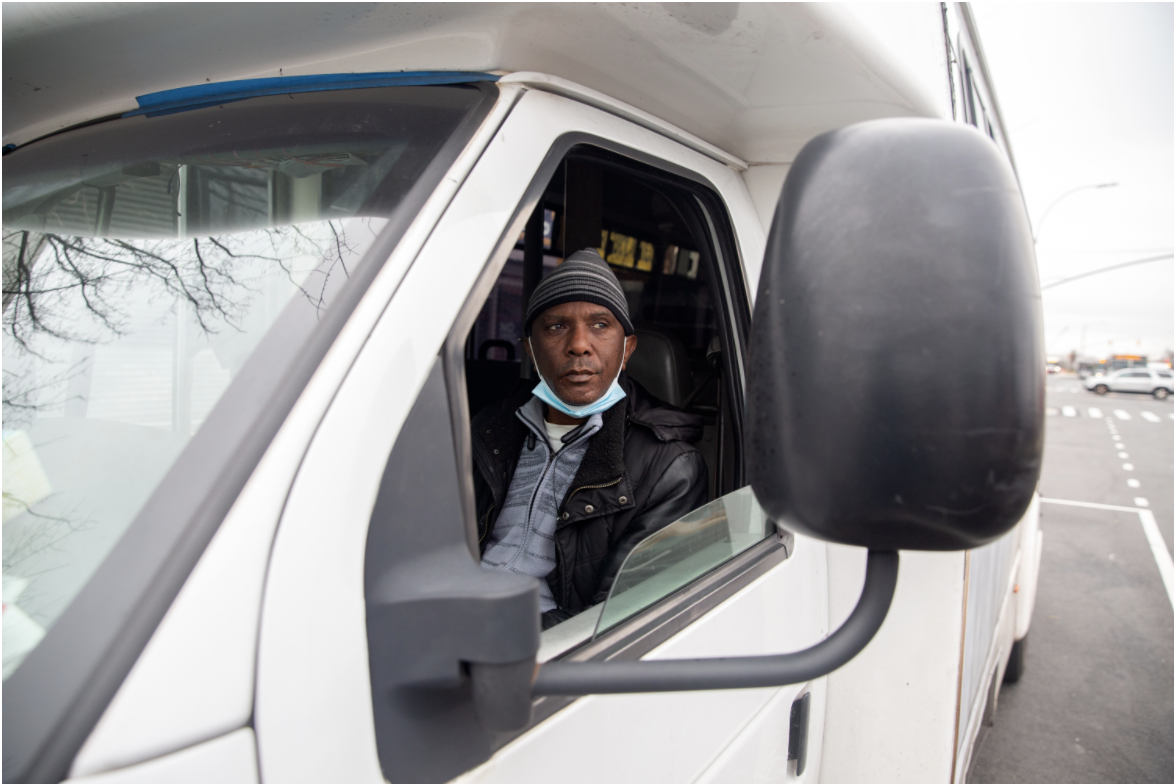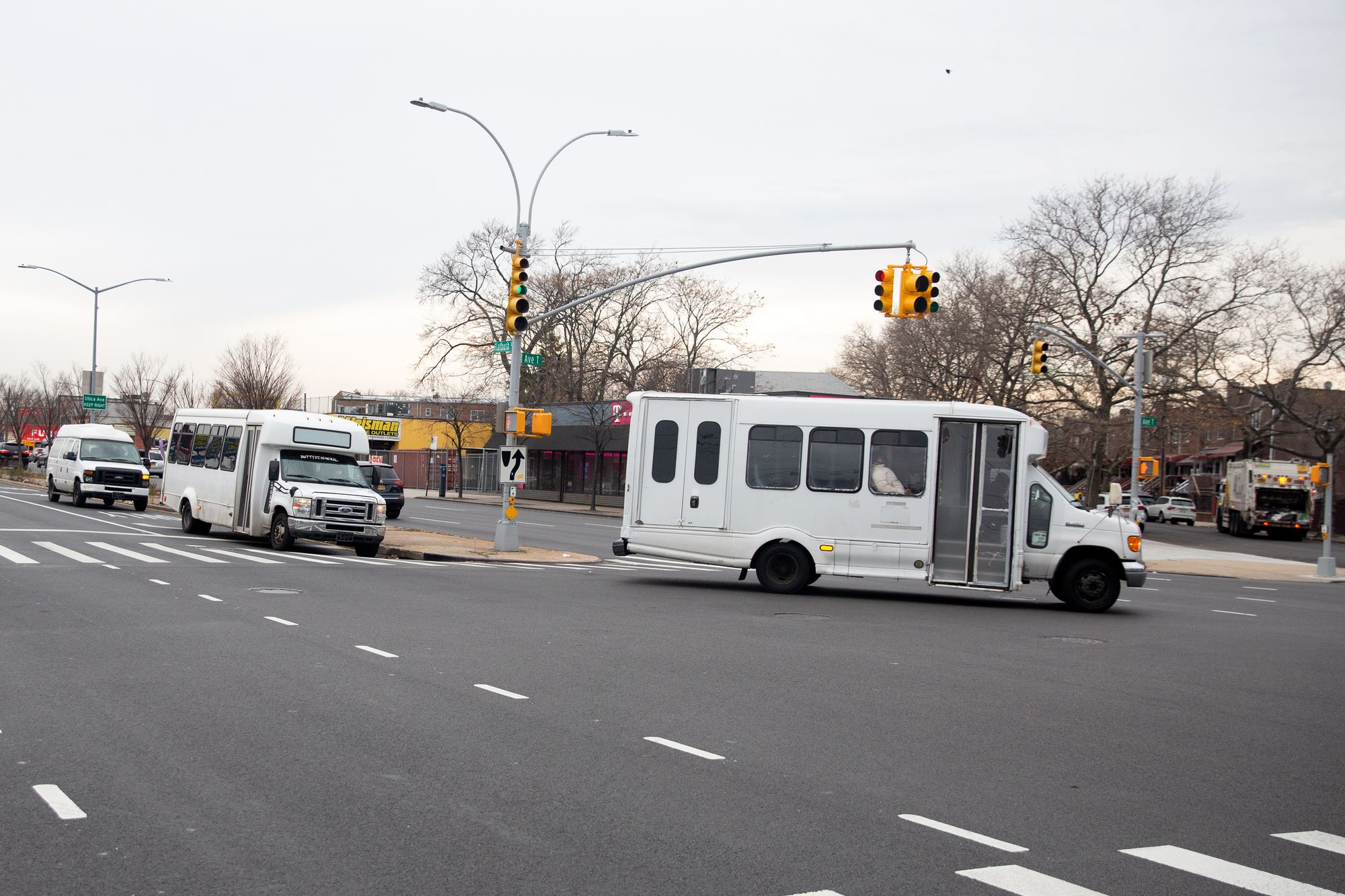Idling Dollar-Van Drivers Hoping for Light at End of Pandemic Tunnel


By Jose Martinez, THE CITY. This article was originally published
by THE CITY

The intersection of Flatbush Avenue and Avenue U in Brooklyn is a hub for New York’s shadow transit network.
Steps from the Kings Plaza shopping mall and a terminal for several MTA bus routes, the stretch of Mill Basin — two miles from the nearest subway station — has traditionally been a prime stop for many of the commuter vans that operate citywide in transit deserts.
“It’s like our own transit system,” said Sandra Martin, 50, as she walked past a bus stop on Flatbush Avenue. “The dollar vans go where the buses do not.”
But nine months into the pandemic, empty commuter vans roll up and down Flatbush, their drivers vainly tooting their horns in search of passengers.
“There’s no good day out here,” said Roan Lindo, 56, a dollar-van driver for 17 years. “I need a 9 to 5 job, because it’s tough out here. It’s bad, bad, bad.”
Taxi & Limousine Commission data shows that just 61 of the 691 commuter vans authorized to operate within specified zones — or fewer than 10% — were in service as of Dec. 9, another indicator of the pandemic’s big hit on the transportation industry.
“Everybody’s staying inside, nobody’s traveling, nobody’s got a job to go to,” said Lindo, who spoke to THE CITY after pulling his empty van off of Flatbush Avenue to sip lentil soup.
The economic hit on the 42 licensed commuter van companies has worsened, industry leaders say, as unlicensed operators compete for the reduced number of passengers who need the rides to get around during the pandemic.
“Most of us are on hold waiting to see when the city will open up fully,” said Hector Ricketts, president of the Commuter Van Association of New York. “We are also looking to see what the economic bailouts will be for businesses.”
‘That’s Who We Are There For’
One driver of an unlicensed dollar van told THE CITY the service is vital to heavily immigrant neighborhoods in Brooklyn, Queens and The Bronx traditionally served by an official and unofficial commuter van network, as seen in this New Yorker map from 2014.
The vans operate in areas that are underserved by mass transit, with no official stops or schedules. Starting at $2 a ride, the cost is usually less than the price of a fare on the bus or subway.
“It’s our people in our community,” said one driver of an unlicensed commuter van, who identified himself by his first name, Jermaine. “The 80-year-old ladies that rely on this thing and wait outside in the cold, that’s who we are there for.”
The unlicensed commuter vans, many of them with out-of-state plates, are reported to outnumber those that are regulated by the city. In March, Public Advocate Jumaane Williams pushed for a crackdown on illegal dollar vans after an unlicensed driver struck a cyclist at Flatbush Avenue and Avenue U.
“I don’t trust them,” said Genifa Bray, 52, who was waiting for a bus at the intersection. “Do they have proper insurance? Do they have a license?”

Ricketts said the overnight subway shutdown that began in May was beneficial to licensed commuter van companies when the MTA contracted with some of them to provide service to passengers who don’t live along bus routes.
But the cash-strapped transit agency cut the night service in August after spending $6 million on for-hire vehicle trips for roughly 1,500 workers nightly. The MTA is now facing thousands of layoffs and massive cuts to bus, subway and commuter rail service without an infusion of billions of dollars in federal aid.
An MTA spokesperson could not specify how much the agency spent on commuter van service as part of the overnight “Essential Connector” program.
“We had an agreement with them and we did deliver,” said Ricketts, who also owns Community Transportation Systems, a 53-vehicle fleet based in Jamaica, Queens. “We hope that in the future we can do more work with them.”
‘Hoping to Find One Passenger’
Lindo, who works as a plumber in addition to driving a van, said he’s usually been surrounded by empty seats while behind the wheel during the COVID-19 crisis.
“Just hoping to find one passenger, maybe two,” he said.
The head of the Taxi & Limousine Commission said a path out of the pandemic is central to a comeback for commuter vans.
“The entire industry, including commuter vans, has been hit hard by the pandemic,” said Commissioner Aloysee Heredia Jarmoszuk, chair of the TLC. “We are hopeful that the COVID-19 vaccines will serve as a catalyst for our recovery.”
THE CITY is an independent, nonprofit news outlet dedicated to hard-hitting reporting that serves the people of New York.



